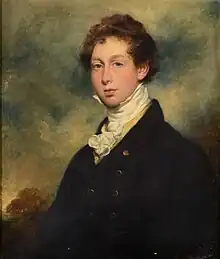
Frederick John Shore (31 May 1799 – 29 May 1837) was a civil servant and judge who worked in the East India Company service in India. He was a son of John Shore, 1st Baron Teignmouth (1751–1834). Unusual for the period, Shore was openly critical of East India Company rule in India. He published under the pen name "A friend to India" in the India Gazette, a Calcutta periodical.
Biography
Shore was born in England, the second son of John Shore, 1st Baron Teignmouth and Charlotte née Cornish (1759-1834). He was baptized at St George Hanover Square, Middlesex on 26th November.[1] He came to India in 1817 as a writer (a junior clerk) and then became an assistant to the secretary of the board of commissioners. He joined the Bengal Civil Service in 1818 and became joint magistrate at Bulandshahr. In 1822 he became superintendent of Dehra Dun, in 1832 Civil & Sessions judge at Fatehgarh, Farrukhabad and from 1836 was Civil Commissioner and Political Agent of the Sagar and Nerbudda Territories.[2] He married Charlotte Mary Cornish (1800-1883) of Devonshire, daughter of his mother's brother, in 1830 and they had three children. His daughter Louisa Sara Floyer (1830–1909) was involved in introducing knitting and needlework into girls' education at the elementary school level in Lincolnshire.[3]
India
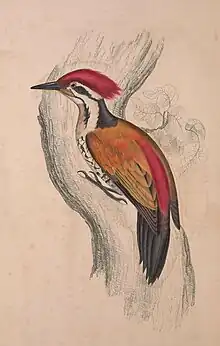
Shore is best known for his notes on English administration in India under the title Notes on Indian Affairs published in two volumes. In it he was outspokenly critical of English administration. He noted the economic condition of the people: "But the halcyon days of India are over; she has been drained of a large proportion of the wealth she once possessed, and her energies have been cramped by a sordid system of misrule to which the interests of millions have been sacrificed for the benefit of the few." .... "The gradual impoverishment of the people and country, under the mode of rule established by the British Government, has hastened their (old merchant princes') fall." He was critical of English ignorance of native languages and considered the judicial system to be a mockery of justice.[4] He was in favour of having a native nobility manage agricultural lands. Shore wore Indian ("mussalman") clothes to court which led to a government order being issued against his practice.[5][6]
Shore served as joint-magistrate of Bulandshahr where he was involved in policing and dealing with the local gurjars.[7] In 1822 he was posted Joint Magistrate and Assistant Collector to Dehra Dun. In order to supply drinking water, he had set up a well near the magistrate's office dug 228 feet deep at the cost of Rs 11,000 (it continues to be called Shore's well).[8] In 1823 he had convict labour build roads around Dehra Dun. At Fatehgarh he had a treadmill to grind corn which was powered by jail labour. The mill house was outside the jail premises but the shaft of the treadmill passed through the wall. This experiment in 1832 which costed Rs 1087 for the government was declared a failure.[9]

In October 1824 Rivers Francis Grindall (1786-1832), the magistrate of Saharanpur sent a letter requesting armed support as a gurjar leader named Kallua (who also called himself Raja Kalyan Singh) and his assistant Kowar Singh had taken over a mud fort called Koonja Ghurry (now Kunja Bahadurpur village in Roorkee district - 29°53′19″N 77°46′26″E / 29.8886°N 77.7740°E) and had sworn by Kali to put an end to the rule by foreigners after assembling 800 men. Frederick Young brought 350[10] of his Sirmoor Battalion made up of gurkha soldiers along with Shore, lieutenant Henry De Bude, and Dr J. F. Royle. During the raid Shore was involved in a sword fight and received two deep cuts on his chest before his assailant was put down by Young with a pistol shot. A biography by Young's daughter claims that Shore had an arrow in his neck.[11] Nearly 200 were killed in the fighting and Kallua was captured and publicly hanged in Saharanpur.[12][13][14]
Captain Mundy described him in 1827 as “A tall handsome man with a long beard, and dressed in Mussalman costume. A great shikarri, the verandahs and rooms of his house filled with stuffed animals. He had two tame bears which sat either side of him at meals, and ate their food out of wooden bowls.”[9] Shore was a keen naturalist who collected bird specimens and John Gould examined his manuscript notes and drawings of birds from India. Gould noted in his Birds of Asia that "but for whose premature death the ornithology of India would have been far better known to us"[15] About 195 of watercolour plates of the birds and notes issued as an appendix to Latham's birds are in the Blacker Wood Library.[16][17] He spent his summers in Dehra Dun and hunted in what is now Mussoorie. The woodpecker Dinopium shorii was named after him by Nicholas Aylward Vigors who examined a specimen exhibited by Frederick's brother C. J. Shore at the Zoological Society of London.[18]
Shore suffered poor health following the injuries from his fight at Koonja but lived for thirteen more years until his sudden death at Spence's Hotel in Calcutta.[19] He is buried in the North Park Street Cemetery, Calcutta.[20]
- Bird illustrations and notes by Shore
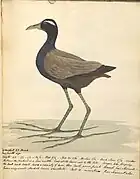
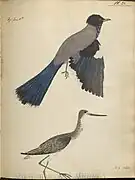
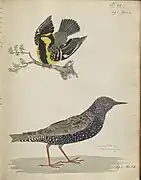
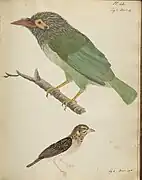
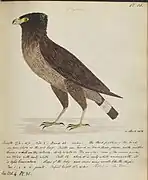
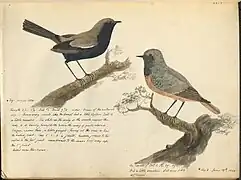
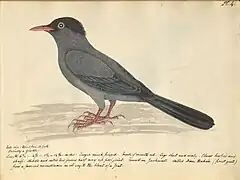
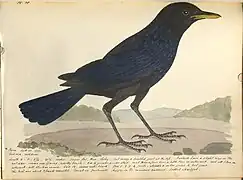
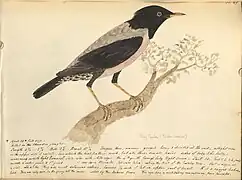
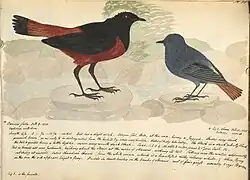
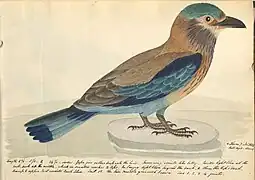
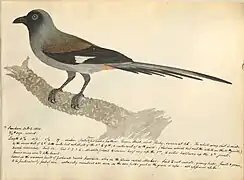
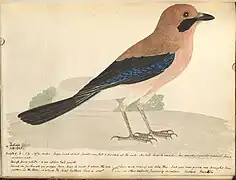
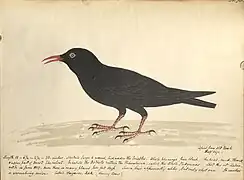
References
- ↑ "Family Search". FamilySearch.
- ↑ Dewar, Douglas (1922). Bygone days in India. London: John Lane. pp. 183–184.
- ↑ Cornish, Vaughan; Baigent, Elizabeth (reviser) (2004). "Floyer, Ernest Ayscoghe (1852–1903)". Oxford Dictionary of National Biography. Oxford Dictionary of National Biography (online ed.). Oxford University Press. doi:10.1093/ref:odnb/33185. (Subscription or UK public library membership required.)
- ↑ Naoroji, Dadabhai (1901). Poverty and un-British rule in India. London: Swan Sonnenschein and Co. pp. 41–43.
- ↑ Cotton, Evan (1927). "The Editor's Note Book". Bengal Past and Present. 34 (1): 136–147.
- ↑ Thompson, George (1840). "Oppressive taxation of British Indian Subjects". Present state of British India: report of a lecture. printed by J. Haddon. pp. 1–4. JSTOR 60228252.
- ↑ Kolff, Dirk H.A. (2010). Grass in their Mouths: The Upper Doab of India under the Company's Magna Charta, 1793-1830. BRILL. doi:10.1163/ej.9789004185029.i-648.16. ISBN 978-90-04-18502-9.
- ↑ Williams, G.R.C. (1874). Historical And Statistical Memoir Of Dehra Doon. p. 5.
- 1 2 Wallace, C.L. (1934). Fatehgarh Camp 1777-1857. Lucknow. pp. 130, 152.
{{cite book}}: CS1 maint: location missing publisher (link) - ↑ Hodson, V.C.P. (1928). List of the officers of the Bengal army, 1758-1834, part IV. London: Constable and Company. pp. 544–545.
- ↑ Jenkins, L. Hadow (1923). General Frederick Young, first commandant of Sirmur battalion (Second Gurka rifles) the life-story of one of the old brigade in India : 1786-1874, including reminiscences of Ireland and India in the 'fifties'. London: George Routledge and Sons. pp. 60–63.
- ↑ Grant, James (1880). Cassell's illustrated History of India. Volume II. London: Cassell Petter & Galpin. pp. 14–15.
- ↑ Walton, H.G. (1911). Dehra Dun. A Gazetteer. District Gazetteers of the United Provinces of Agra and Oudh. Volume I. Allahabad. pp. 184–191.
{{cite book}}: CS1 maint: location missing publisher (link) - ↑ Woodruff, Philip (1957). The Men who ruled India. The Founders. London: Jonathan Cape. p. 290.
- ↑ Gould, John (1883). The Birds of Asia. Volume 6. p. 74.
- ↑ Shore, F.J. (1827). MS. appendix to Latham's Birds with original paintings.
- ↑ Wood, Casey A. (1931). An introduction to the literature of vertebrate zoology. McGill University. p. 130.
- ↑ Vigors, N.A. (1832). "[Meeting notes]". Proceedings of the Committee of Science and Correspondence of the Zoological Society of London (1): 175.
- ↑ "The Hon. F.J. Shore". The Asiatic Journal and Monthly Register for British and Foreign India, China, Australasia. 24: 149–150. 1837.
- ↑ Wilson, C.R., ed. (1896). List of inscriptions on tombs or monuments in Bengal. Office of the Superintendent of Government Printing, Calcutta. p. 96.
External links
- Notes on Indian Affairs. Volume 1 Volume 2 (1837)
- Manuscript appendix to Latham's Birds with original paintings - Parts 1 and 2 Part 3
- Shore in Dehra Dun
- Archival records at the British Library